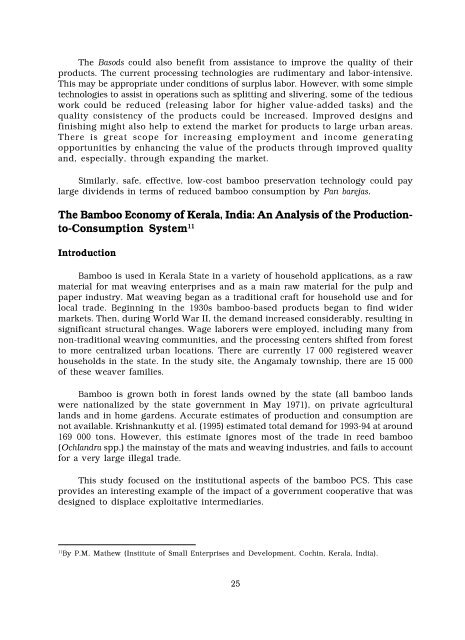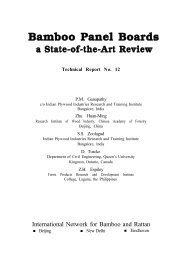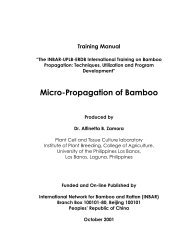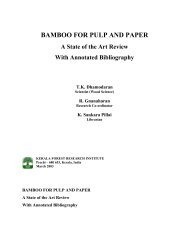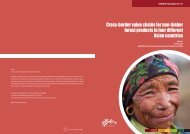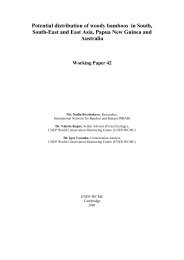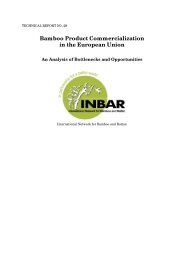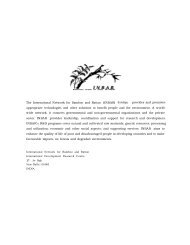The Bamboo and Rattan Sectors in Asia: an Analysis of ... - INBAR
The Bamboo and Rattan Sectors in Asia: an Analysis of ... - INBAR
The Bamboo and Rattan Sectors in Asia: an Analysis of ... - INBAR
You also want an ePaper? Increase the reach of your titles
YUMPU automatically turns print PDFs into web optimized ePapers that Google loves.
<strong>The</strong> Basods could also benefit from assist<strong>an</strong>ce to improve the quality <strong>of</strong> their<br />
products. <strong>The</strong> current process<strong>in</strong>g technologies are rudimentary <strong><strong>an</strong>d</strong> labor-<strong>in</strong>tensive.<br />
This may be appropriate under conditions <strong>of</strong> surplus labor. However, with some simple<br />
technologies to assist <strong>in</strong> operations such as splitt<strong>in</strong>g <strong><strong>an</strong>d</strong> sliver<strong>in</strong>g, some <strong>of</strong> the tedious<br />
work could be reduced (releas<strong>in</strong>g labor for higher value-added tasks) <strong><strong>an</strong>d</strong> the<br />
quality consistency <strong>of</strong> the products could be <strong>in</strong>creased. Improved designs <strong><strong>an</strong>d</strong><br />
f<strong>in</strong>ish<strong>in</strong>g might also help to extend the market for products to large urb<strong>an</strong> areas.<br />
<strong>The</strong>re is great scope for <strong>in</strong>creas<strong>in</strong>g employment <strong><strong>an</strong>d</strong> <strong>in</strong>come generat<strong>in</strong>g<br />
opportunities by enh<strong>an</strong>c<strong>in</strong>g the value <strong>of</strong> the products through improved quality<br />
<strong><strong>an</strong>d</strong>, especially, through exp<strong><strong>an</strong>d</strong><strong>in</strong>g the market.<br />
Similarly, safe, effective, low-cost bamboo preservation technology could pay<br />
large dividends <strong>in</strong> terms <strong>of</strong> reduced bamboo consumption by P<strong>an</strong> barejas.<br />
<strong>The</strong> <strong>Bamboo</strong> Economy <strong>of</strong> Kerala, India: An <strong>Analysis</strong> <strong>of</strong> the Productionto-Consumption<br />
System 11<br />
Introduction<br />
<strong>Bamboo</strong> is used <strong>in</strong> Kerala State <strong>in</strong> a variety <strong>of</strong> household applications, as a raw<br />
material for mat weav<strong>in</strong>g enterprises <strong><strong>an</strong>d</strong> as a ma<strong>in</strong> raw material for the pulp <strong><strong>an</strong>d</strong><br />
paper <strong>in</strong>dustry. Mat weav<strong>in</strong>g beg<strong>an</strong> as a traditional craft for household use <strong><strong>an</strong>d</strong> for<br />
local trade. Beg<strong>in</strong>n<strong>in</strong>g <strong>in</strong> the 1930s bamboo-based products beg<strong>an</strong> to f<strong>in</strong>d wider<br />
markets. <strong>The</strong>n, dur<strong>in</strong>g World War II, the dem<strong><strong>an</strong>d</strong> <strong>in</strong>creased considerably, result<strong>in</strong>g <strong>in</strong><br />
signific<strong>an</strong>t structural ch<strong>an</strong>ges. Wage laborers were employed, <strong>in</strong>clud<strong>in</strong>g m<strong>an</strong>y from<br />
non-traditional weav<strong>in</strong>g communities, <strong><strong>an</strong>d</strong> the process<strong>in</strong>g centers shifted from forest<br />
to more centralized urb<strong>an</strong> locations. <strong>The</strong>re are currently 17 000 registered weaver<br />
households <strong>in</strong> the state. In the study site, the Angamaly township, there are 15 000<br />
<strong>of</strong> these weaver families.<br />
<strong>Bamboo</strong> is grown both <strong>in</strong> forest l<strong><strong>an</strong>d</strong>s owned by the state (all bamboo l<strong><strong>an</strong>d</strong>s<br />
were nationalized by the state government <strong>in</strong> May 1971), on private agricultural<br />
l<strong><strong>an</strong>d</strong>s <strong><strong>an</strong>d</strong> <strong>in</strong> home gardens. Accurate estimates <strong>of</strong> production <strong><strong>an</strong>d</strong> consumption are<br />
not available. Krishn<strong>an</strong>kutty et al. (1995) estimated total dem<strong><strong>an</strong>d</strong> for 1993-94 at around<br />
169 000 tons. However, this estimate ignores most <strong>of</strong> the trade <strong>in</strong> reed bamboo<br />
(Ochl<strong><strong>an</strong>d</strong>ra spp.) the ma<strong>in</strong>stay <strong>of</strong> the mats <strong><strong>an</strong>d</strong> weav<strong>in</strong>g <strong>in</strong>dustries, <strong><strong>an</strong>d</strong> fails to account<br />
for a very large illegal trade.<br />
This study focused on the <strong>in</strong>stitutional aspects <strong>of</strong> the bamboo PCS. This case<br />
provides <strong>an</strong> <strong>in</strong>terest<strong>in</strong>g example <strong>of</strong> the impact <strong>of</strong> a government cooperative that was<br />
designed to displace exploitative <strong>in</strong>termediaries.<br />
11 By P.M. Mathew (Institute <strong>of</strong> Small Enterprises <strong><strong>an</strong>d</strong> Development, Coch<strong>in</strong>, Kerala, India).<br />
25


